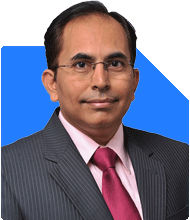Ramalingam Kalirajan |10870 Answers |Ask -Follow
Mutual Funds, Financial Planning Expert - Answered on May 14, 2025
He has an MBA in finance from the University of Madras and is a certified financial planner.
He is the director and chief financial planner at Holistic Investment, a Chennai-based firm that offers financial planning and wealth management advice.... more

Namaste sir, I am 38 years old and having monthly salary of around 1.5 lakhs, I took home loan of 6869000 from Bank of Baroda with ROI at 8.45% in 2024 for 250 months, which leads to EMI of 59480. I did a pre payment of 2 lakhs within first 6 months, I am planning to do an extra EMI every year. I have around 25k SIP towards MF(spread across large cap, midcap and small cap) I have FD of around 8L as emergency fund. Please suggest me any changes required in my approach. I have monthly expenses of around 60k(house maintenance, parents and self health insurance)
You have a home loan of Rs. 68.69 lakh at 8.45% interest.
You are paying Rs. 59,480 as EMI for 250 months.
You did a prepayment of Rs. 2 lakh in the first 6 months.
You are planning to make one extra EMI every year.
You are investing Rs. 25,000 monthly in mutual funds.
Your SIP is diversified across large, mid, and small-cap.
You have Rs. 8 lakh in FD as an emergency fund.
Your monthly expenses are around Rs. 60,000.
Your approach is strong and structured. Let us now assess in detail.
1. Loan Management Strategy
You started prepayment in the first year itself. That is a very wise decision.
Your idea to pay an extra EMI each year is a great discipline.
This reduces your interest cost significantly over the long term.
Continue this pattern without breaking the cycle.
If possible, increase the prepayment amount as your salary grows.
Ensure you inform the bank clearly to adjust this as principal reduction.
Do not extend tenure while doing prepayments. Always reduce tenure.
Track interest statements yearly to measure progress of repayment.
Avoid taking any fresh loans during this tenure.
Any bonus or arrears should go towards prepayment first.
2. Emergency Fund Evaluation
Rs. 8 lakh FD as an emergency fund is a very strong cushion.
Your expenses are Rs. 60,000 per month. So you have over 12 months of coverage.
That is sufficient and a sign of thoughtful planning.
Keep this FD linked to a savings account for liquidity.
Prefer sweep-in FDs or flexi-FDs if your bank allows.
Keep emergency corpus untouched unless actual emergency happens.
Replenish the FD immediately after any withdrawal.
3. Mutual Fund Investment Approach
SIP of Rs. 25,000 monthly is a strong habit. Keep continuing.
You have spread investments across large, mid, and small-cap. Good diversification.
Avoid direct funds. They seem cheaper but carry hidden behavioural costs.
Regular plans through a qualified Mutual Fund Distributor (with CFP) are better.
A Certified Financial Planner guides portfolio changes during market cycles.
This helps prevent panic redemption or poor fund switches.
Active funds managed by professionals can beat market returns.
Index funds lack active risk management. They mirror the market blindly.
Active funds have better downside protection and consistent alpha generation.
Always invest based on financial goals. Don't choose funds just by past returns.
Review your mutual fund portfolio once every 6 months.
Ensure proper allocation between equity and hybrid funds.
You can add hybrid funds to manage volatility.
If your goals are within 5 years, avoid small-cap funds.
For retirement or long-term goals, continue with equity allocation.
Increase SIP amount yearly based on salary hike.
4. Insurance Protection for Family
You mentioned expenses include health insurance. That’s good to note.
Ensure you have at least Rs. 10 lakh family floater plan.
Add Rs. 5 lakh top-up or super top-up plans if budget permits.
Maintain separate health cover for parents, not combined.
If your parents are above 60, choose senior citizen health policies.
Ensure you have term insurance of at least 15 to 20 times your yearly income.
Term insurance is low-cost and provides high coverage.
Do not mix insurance with investment.
Avoid ULIPs, money-back or endowment policies.
If you already have any such policies, assess the surrender value.
Consider moving to mutual funds instead for wealth creation.
Health and life cover must be reviewed yearly.
5. Budgeting and Cash Flow Management
You save over Rs. 30,000 monthly after EMI and expenses.
Keep part of that for planned home improvement or maintenance.
Maintain a separate bank account only for investments and prepayments.
Avoid impulsive spending from savings account.
If any other loan exists, try to close them first.
Avoid spending on credit cards unless you pay full amount.
Use mobile apps to track monthly cash flows.
Check credit score every year to stay informed.
Reassess spending patterns yearly with inflation.
6. Goal Based Planning
Define short, mid, and long-term goals.
For example, children’s education, car replacement, retirement, travel.
Assign timelines and expected cost for each goal.
Align mutual funds to each goal based on horizon.
Short-term goals need low-risk funds like hybrid or debt-oriented funds.
Long-term goals can use equity or multi-cap funds.
Use SIPs for long-term goals and lumpsum for short-term needs.
If you have children, plan for their college fund from now.
Education inflation is very high in India.
Use goal calculators with guidance from a Certified Financial Planner.
Don’t delay setting up each goal’s investment.
7. Tax Planning Assessment
Use Section 80C limit of Rs. 1.5 lakh smartly.
Avoid PPF unless needed. Mutual fund ELSS can be better for wealth creation.
ELSS has a lock-in of 3 years, shortest among tax-saving options.
Claim home loan principal under 80C and interest under Section 24(b).
File ITR every year on time with proper declaration.
Maintain investment proofs, premium receipts, loan statements.
For mutual fund gains, understand taxation properly.
Equity funds have 12.5% tax on LTCG above Rs. 1.25 lakh.
Short-term gains on equity taxed at 20%.
Debt fund gains taxed as per your income slab.
Plan redemptions and switch timing to manage taxes efficiently.
8. Retirement Preparedness Check
You are 38 now. You still have over 20 years to retire.
Your SIPs and loan prepayments are helping your retirement indirectly.
But consider setting up a separate retirement fund now.
Use diversified equity funds and hybrid funds for this.
Increase SIPs yearly to match your retirement target.
Estimate your post-retirement monthly need today.
Account for inflation and rising medical expenses.
Avoid delaying retirement planning further. Time is more valuable than money.
Your consistent investment can give compounding benefits.
9. Avoid Common Mistakes
Don’t stop SIPs during market corrections.
Don’t switch funds frequently chasing performance.
Don’t rely only on employer health cover.
Don’t mix insurance and investment.
Don’t withdraw from emergency fund for planned goals.
Don’t invest in real estate for rental income or tax saving.
Don’t invest based on friend or social media advice.
10. Additional Recommendations
Create a Will or nomination for all accounts.
Ensure all your investments are properly documented.
Keep your spouse informed about investments and loans.
Review loan insurance if taken during home loan process.
Use a single consolidated app or platform for investment tracking.
Store important documents in cloud-based vault.
Maintain a checklist for annual financial review.
Finally
Your financial foundation is very strong.
You are doing SIPs regularly, repaying loan smartly, and saving consistently.
You have health insurance and emergency fund in place.
These are great financial habits to maintain.
Now focus on goal planning and better fund alignment.
Keep increasing SIPs, continue prepayment, and avoid distractions.
Use a Certified Financial Planner to review your plan every year.
Your goals can be achieved with patience and consistency.
Make small improvements every year. They bring big results.
Best Regards,
K. Ramalingam, MBA, CFP,
Chief Financial Planner,
www.holisticinvestment.in
https://www.youtube.com/@HolisticInvestment
You may like to see similar questions and answers below
Ramalingam Kalirajan |10870 Answers |Ask -Follow
Mutual Funds, Financial Planning Expert - Answered on Jul 18, 2024
Ramalingam Kalirajan |10870 Answers |Ask -Follow
Mutual Funds, Financial Planning Expert - Answered on Jul 16, 2024
Ramalingam Kalirajan |10870 Answers |Ask -Follow
Mutual Funds, Financial Planning Expert - Answered on May 14, 2025
Janak Patel |71 Answers |Ask -Follow
MF, PF Expert - Answered on May 20, 2025
Ramalingam Kalirajan |10870 Answers |Ask -Follow
Mutual Funds, Financial Planning Expert - Answered on Aug 28, 2025
Dr Dipankar Dutta |1837 Answers |Ask -Follow
Tech Careers and Skill Development Expert - Answered on Dec 05, 2025
Dr Shyam Jamalabad |108 Answers |Ask -Follow
Dentist - Answered on Dec 05, 2025
Dr Shyam Jamalabad |108 Answers |Ask -Follow
Dentist - Answered on Dec 05, 2025
Dr Shyam Jamalabad |108 Answers |Ask -Follow
Dentist - Answered on Dec 05, 2025
Dr Dipankar Dutta |1837 Answers |Ask -Follow
Tech Careers and Skill Development Expert - Answered on Dec 05, 2025
Ulhas Joshi |280 Answers |Ask -Follow
Mutual Fund Expert - Answered on Dec 05, 2025
Dr Dipankar Dutta |1837 Answers |Ask -Follow
Tech Careers and Skill Development Expert - Answered on Dec 04, 2025
Ravi Mittal |676 Answers |Ask -Follow
Dating, Relationships Expert - Answered on Dec 04, 2025
Anu Krishna |1745 Answers |Ask -Follow
Relationships Expert, Mind Coach - Answered on Dec 04, 2025
Anu Krishna |1745 Answers |Ask -Follow
Relationships Expert, Mind Coach - Answered on Dec 04, 2025


























